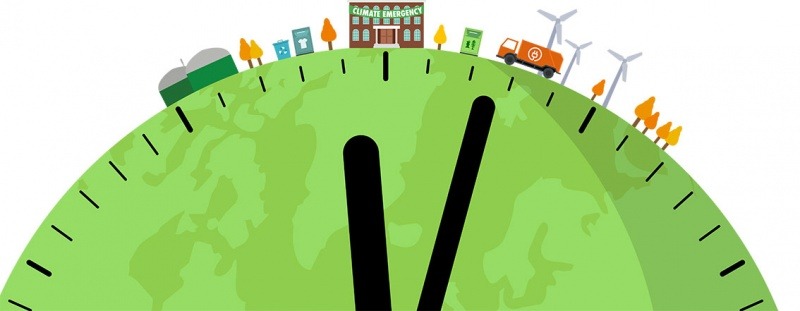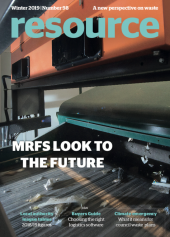No time to waste
Local authorities across the UK are declaring Climate Emergencies, committing to reducing their carbon emissions to net zero. But how can their waste management contribute to that aim? Imogen Benson reports

Since the UN’s Intergovernmental Panel on Climate Change (IPCC) revealed that we only have until 2030 to limit global temperature rises between 1.5°C and 2°C above pre- industrial levels, the Climate Emergency movement has snowballed into a worldwide drive for environmental action.
Following Bristol City Council’s lead, over half of the UK’s local authorities have now made Climate Emergency declarations, with the majority committing to reaching carbon net neutrality by 2030.
Passing a Climate Emergency declaration is to be applauded, but it is only the start of the process. The diagnosis has been made, now the search for a cure begins. A declaration must be followed by a wide- ranging yet coherent strategy for reducing carbon emissions to net zero by the target date, with such a strategy touching on all sectors of the economy.
Alongside policies to reduce the climate impact of energy, heating and transport, councils must consider how the municipal waste management system can play a critical role in delivering net-zero.
Carbon intensity
The introduction of the landfill tax in 1996 has had an immense impact on reducing the waste sector’s carbon footprint – emissions from waste have fallen by 70 per cent since 1990. But despite this long-term reduction, our waste and the way we manage it remains highly carbon-intensive.
“When an item is thrown out, we must consider the wasted emissions from transport, resource extraction, manufacture, retail, the household and waste management,” says Iain Gulland, Chief Executive of Zero Waste Scotland, which developed the Carbon Metric, a carbon-based alternative to traditional weight-based measurements. “The Carbon Metric measures this whole-life carbon impact, regardless of where in the world these impacts occur.”
Gulland explains that there is no correlation between the weight of waste and its environmental impact, with some waste streams, for instance textiles, producing disproportionate emissions compared to its volume. He explains: “The top five most carbon intensive materials (food waste, mix metals, paper and card, textiles, plastic) accounted for just under two thirds (65 per cent) of all household waste in 2018, but 89 per cent of household waste carbon impacts. Food waste accounted for 25 per cent of household waste by weight, but 32 per cent of household waste carbon impacts. Textile waste made up just six per cent of household waste arisings, but 34 per cent of the carbon impacts.”
Designing strategies
While assessing the carbon impacts of waste is not new, devising strategies to directly address the climate emergency is an emerging area of policy, explains Ann Ballinger, Principal Consultant at Eunomia Research and Consulting, which has played a key role in helping councils to develop climate emergency strategies.
“A key question is – what emissions are you accounting for within your appraisal?” says Ballinger. “Historically, local authority emissions inventories have only considered carbon emissions that occur close to home – so-called territorial emissions. For the waste sector, this limits the scope to considering only emissions from residual waste treatment facilities such as landfill and incineration.”
Ballinger explains that the most effective change will prioritise the reduction of waste. “Emissions reductions tend to follow the waste hierarchy, where emissions associated with different activities are considered on the basis of one tonne of material. For example, benefits arising from food waste prevention are many times higher than the benefits of treating food waste from even the best performing system treating source segregated food waste,” says Ballinger.
Stroud District Council, which became the first carbon neutral European council in 2015 , has developed a Climate Emergency implementation plan with a strong focus on waste reduction – the council currently only produces 258.6 kilogrammes of residual waste per household. After the council’s Environment Committee first discussed the Climate Emergency report back in June, the council has now appointed a carbon-neutral 2030 officer and has already begun to take action to reduce emissions.
“It’s a massive challenge, but clearly the first thing to do is to minimise the amount of residual waste sent to landfill,” says Simon Pickering, Chair of the council’s Environment Committee.
“Our waste collection system involves just one fortnightly 140-litre residual waste bin, which forces people to think carefully about their recycling. We also have two weekly 140-litre bins for commingled recycling, with a separate collection for paper and cardboard and weekly separate food waste collection.”
On a national level, although behaviour change is a crucial part of reducing residual waste, Ballinger argues that higher taxation could be necessary. “Higher taxes on residual waste will help drive waste away from the residual stream, thereby helping ensure a focus on recycling and reuse,” she explains. “The introduction of an incineration tax would help ensure the drive away from residual continues to happen as landfill levels continue to drop. Clearly local authorities do not have control over taxation, so this requires action from central government.”
As well as waste reduction, Stroud’s strategy also considers the emissions associated with the collection of waste. “The other side of the big challenge is the fuel use,” Pickering says. “Working with Ubico, our collection partner, we’re continually looking at the optimisation of rounds to ensure that they’re efficient. We’re gradually shifting to electric vehicles and our big challenge is moving to fully electric refuse wagons – we know that a number of authorities are doing this, so this is something we’re actively looking at.”
Although the council aims to electrify the entire waste collection fleet, Pickering points out the challenges of doing so in a rural district: “Our concern is that if you have a much longer round that goes up large hills, then we don’t know the length of charge.”
Delivering change
Although Stroud has introduced a separate food waste collection service, Pickering admits that this alone is not enough: “Now we’ve implemented a system, the next stage is to change behaviour. We’re going to be running an education campaign focusing on food waste to try and get people to cut down on the amount of food they throw away in the first place.”
Home composting could also provide a solution, allowing councils to kill two birds with one stone by saving money on collection and disposal costs whilst also reducing the carbon impact of food waste disposal. Pickering explains that Stroud is promoting home composting by offering subsidised compost bins and supporting a community composting scheme in Bisley.
 This article was taken from Issue 98
This article was taken from Issue 98Textiles, another carbon intensive waste stream, must also be targeted if councils are to achieve net- zero. Describing textiles as a “particularly challenging waste stream”, Simon explains that the community group Transition Stroud are doing a lot of promotion around textile waste – Pickering recently acted as compère for the group’s ‘Trashion Show’, which encourages reuse and repair by showcasing outfits made from upcycled clothes.
Although Stroud is making progress, Pickering explains that they are now waiting for government action. “If the Resources and Waste Strategy is implemented by the next government or they give us an idea of what’s going on, then we can think about what to do next.”
“At the moment, it’s about keeping the momentum going. The key is to come up with clear and simple messages to not overcomplicate it.”
Cllr Darren Rodwell, the Environment Spokesperson for the Local Government Association (LGA) calls for further investment from the government. “The efforts of councils are restricted by the lack of funding and devolved powers and overly complex bureaucracy.”
“This is why the LGA is offering the government to set up a joint national taskforce comprising local leaders and relevant government departments to determine the funding, legislation and policy changes needed to deliver zero net carbon emissions by 2030.”
Bringing an end to ‘business-as-usual’ will not be
an easy journey – now that Climate Emergencies
have been declared, it’s time for councils to take the next steps in the transition towards a circular, zero-emissions economy. With only ten years left to achieve carbon neutrality, there’s no time to waste. 




